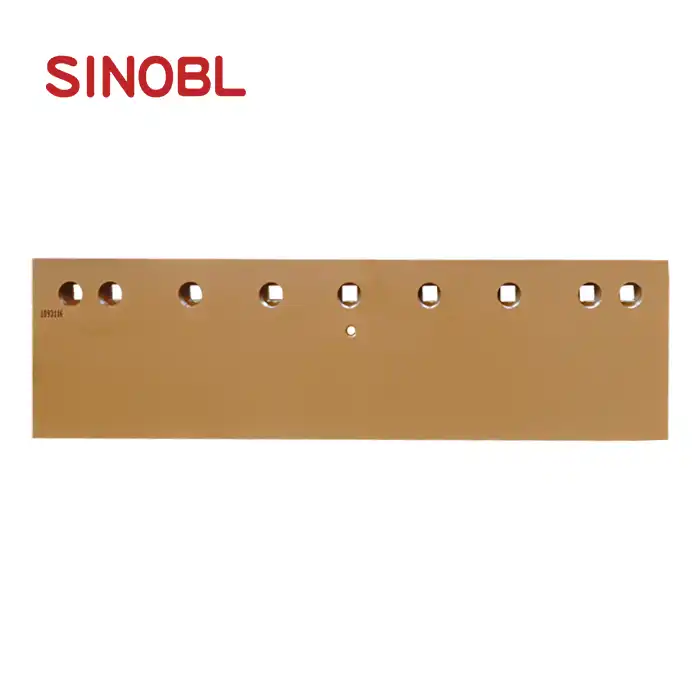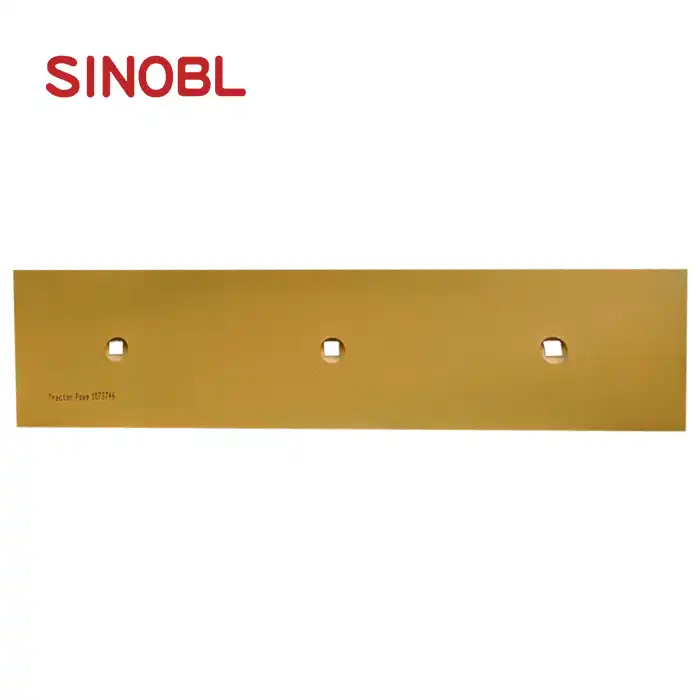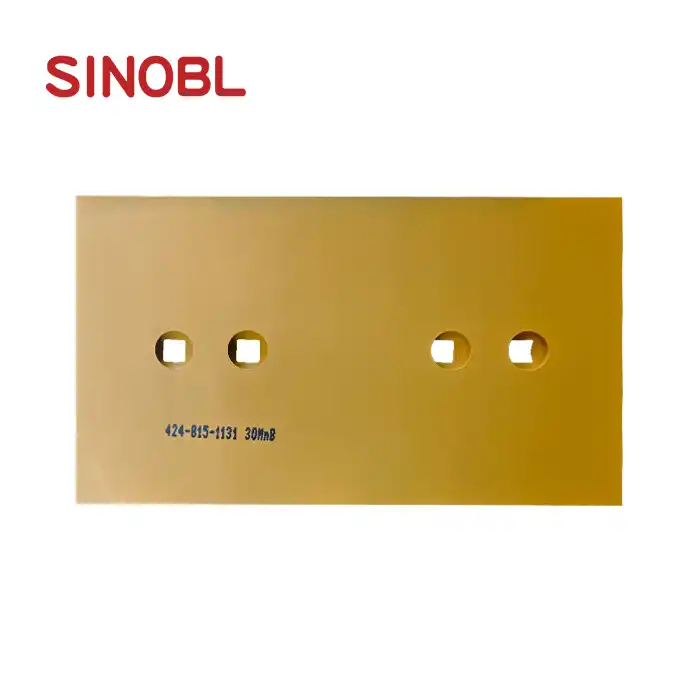What steel grade is used in Dozer Edge-Cutting 4T2988?
The Dozer Edge-Cutting 4T2988 manufactured by Shanghai Sinobl Precision Machinery Co., Ltd. utilizes premium-grade High Carbon Steel combined with Heat-Treated Boron Steel. This strategic combination delivers exceptional wear resistance and durability in demanding construction and mining environments. The advanced metallurgical composition of these materials enables the cutting edge to withstand extreme pressure, impact, and abrasion while maintaining structural integrity throughout extended operational periods. SINOBL's engineering team has optimized this steel formulation specifically for the 4T2988 model to ensure maximum performance across diverse terrain conditions while extending replacement intervals for improved operational efficiency.
The Superior Steel Composition of Dozer Edge-Cutting 4T2988
High Carbon Steel: The Foundation of Durability
High Carbon Steel forms the fundamental material component in the Dozer Edge-Cutting 4T2988, providing exceptional hardness and wear resistance critical for bulldozer operations. This specialized steel typically contains carbon content ranging from 0.60% to 0.95%, significantly higher than standard construction steels. The elevated carbon concentration creates a microstructure that resists deformation and abrasion when the Dozer Edge-Cutting 4T2988 encounters rocks, compacted soil, and other abrasive materials. SINOBL's manufacturing process further enhances these inherent properties through precision forging techniques that align the steel's grain structure for optimal strength distribution. The carbon content is meticulously controlled during production to achieve the perfect balance between hardness and toughness, preventing the brittleness that can lead to premature failure. Additionally, the High Carbon Steel used in the Dozer Edge-Cutting 4T2988 contains carefully calibrated amounts of manganese and silicon, which improve hardenability and deoxidize the steel during manufacturing, resulting in a more homogeneous material structure with fewer imperfections that could become failure points during operation.
Heat-Treated Boron Steel: Enhancing Performance
The incorporation of Heat-Treated Boron Steel represents a significant advancement in the metallurgical engineering of the Dozer Edge-Cutting 4T2988. Boron, when added in precise amounts (typically 0.001% to 0.003%), dramatically improves the hardenability of steel without compromising its formability during manufacturing. The Dozer Edge-Cutting 4T2988 benefits enormously from this property, as it allows for complex geometries while maintaining exceptional performance characteristics. SINOBL employs a sophisticated heat treatment process that includes controlled heating to approximately 900°C followed by rapid quenching in specialized polymer solutions to achieve optimal hardness values exceeding 45-50 HRC (Rockwell Hardness C-scale) at critical wear surfaces. This process creates a martensitic microstructure that exhibits superior resistance to impact and abrasion compared to conventional steels. The boron additive reduces the critical cooling rate required for martensitic transformation, ensuring thorough hardening throughout the entire cross-section of the Dozer Edge-Cutting 4T2988, even in its thickest sections. This comprehensive hardening is crucial for maintaining consistent performance throughout the service life of the component, preventing premature wear patterns that might otherwise develop in improperly hardened cutting edges.

Material Quality Control Processes
SINOBL implements rigorous quality control protocols throughout the procurement and manufacturing stages to ensure the Dozer Edge-Cutting 4T2988 consistently meets exacting material standards. Each batch of raw steel undergoes comprehensive spectrographic analysis to verify chemical composition, including precise measurement of carbon, boron, and trace elements that influence performance characteristics. Metallurgical laboratories conduct microstructure evaluations using advanced optical and electron microscopy to confirm proper grain development and martensite formation in the Dozer Edge-Cutting 4T2988 after heat treatment. Hardness testing is performed at multiple points across each cutting edge using calibrated equipment to verify uniform hardness distribution, with acceptance criteria requiring consistently high Rockwell C values appropriate for severe abrasion applications. Additionally, SINOBL conducts regular impact resistance tests to ensure the Dozer Edge-Cutting 4T2988 maintains adequate toughness to resist cracking and fracture under impact loads. The company maintains detailed material traceability systems that document the complete production history of each Dozer Edge-Cutting 4T2988, from raw material sourcing through final inspection, ensuring accountability throughout the manufacturing process and facilitating continuous improvement initiatives based on field performance data.
Performance Characteristics of 4T2988's Advanced Steel
Exceptional Wear Resistance in Extreme Conditions
The specially formulated steel combination in the Dozer Edge-Cutting 4T2988 delivers extraordinary resistance to abrasive wear across diverse operating environments. Field tests conducted in harsh mining operations demonstrate wear rates approximately 30-40% lower than standard carbon steel alternatives, translating to significantly extended service intervals. The Dozer Edge-Cutting 4T2988 maintains its cutting efficiency even when operating in highly abrasive materials containing quartz and other hard minerals that typically accelerate wear on conventional cutting edges. This superior performance stems from the optimized microstructure achieved through SINOBL's proprietary heat treatment protocols, which develop exceptionally hard carbide formations distributed uniformly throughout the steel matrix. These microscopic carbides serve as reinforcing elements that shield the surrounding material from abrasive forces. The dimensional stability of the Dozer Edge-Cutting 4T2988 throughout its service life ensures consistent ground engagement and material flow, preventing the development of irregular wear patterns that can compromise bulldozer efficiency. Additionally, the wear-resistant properties extend to the mounting holes and surfaces, maintaining proper fitment and preventing the loosening that often occurs with less sophisticated cutting edges. This comprehensive resistance to wear makes the Dozer Edge-Cutting 4T2988 particularly valuable in remote operations where maintenance access is limited and equipment availability is critical to project timelines.

Impact Resistance and Fracture Prevention
While maximizing hardness for wear resistance, SINOBL engineers have carefully balanced the metallurgical properties of the Dozer Edge-Cutting 4T2988 to maintain exceptional impact resistance. This critical characteristic prevents catastrophic failures when encountering immovable objects or extremely hard materials during operation. The Heat-Treated Boron Steel component contributes significantly to impact absorption capacity, with its refined grain structure dispersing impact energy throughout the material rather than concentrating stress at the point of impact. Sophisticated computer modeling guides the design of internal stress distribution pathways within the Dozer Edge-Cutting 4T2988, redirecting force away from vulnerable areas. The strategic combination of materials creates a graduated hardness profile, with slightly increased toughness in regions prone to impact loading while maintaining maximum hardness at primary wear surfaces. SINOBL's manufacturing process includes controlled cooling stages that relieve internal stresses without compromising hardness, further enhancing the Dozer Edge-Cutting 4T2988's resistance to crack initiation and propagation. This balanced approach ensures the cutting edge delivers reliable performance even in unpredictable terrain containing hidden obstacles or frozen ground that generates extreme impact forces. Operators benefit from reduced downtime associated with edge failure, supporting continuous productivity in challenging environments where bulldozers frequently encounter variable and unpredictable material conditions.
Longevity and Cost Efficiency
The advanced steel formulation employed in the Dozer Edge-Cutting 4T2988 delivers compelling economic advantages through extended service life and reduced replacement frequency. Operational cost analyses demonstrate that the initial investment in SINOBL's premium cutting edge typically yields returns of 2.5-3.5 times when considering the total cost of ownership, including purchase price, installation labor, equipment downtime, and productivity impacts. The Dozer Edge-Cutting 4T2988's dimensional stability throughout its wear life prevents the progressive degradation of cutting efficiency commonly observed with inferior edges, maintaining optimal material displacement capabilities from installation until replacement. The exceptional wear characteristics reduce the frequency of maintenance interventions, allowing operators to establish more predictable maintenance schedules and improve fleet utilization rates. SINOBL's material technology enables the Dozer Edge-Cutting 4T2988 to maintain its critical cutting geometry longer than conventional options, preserving the bulldozer's effective pushing force and fuel efficiency throughout extended operational periods. The reduced replacement frequency generates additional sustainability benefits by lowering the overall material consumption and environmental impact associated with manufacturing replacement components. For large operations managing multiple bulldozers, the aggregate economic benefit of implementing Dozer Edge-Cutting 4T2988 components across the fleet can represent substantial operational savings while simultaneously improving equipment availability rates and project timeline compliance.

Manufacturing Processes that Optimize Steel Properties
Precision Heat Treatment Techniques
SINOBL employs sophisticated heat treatment methodologies that fundamentally transform the microstructural properties of the Dozer Edge-Cutting 4T2988's steel composition. The multi-stage thermal processing begins with precision-controlled austenitizing, where the cutting edges are heated to temperatures between 850-930°C in computer-monitored furnaces that maintain temperature uniformity within ±5°C throughout the entire component. This critical phase dissolves existing carbon structures and prepares the metal for subsequent hardening. The Dozer Edge-Cutting 4T2988 then undergoes an engineered quenching process using proprietary polymer-enhanced quenchants that extract heat at optimal rates to achieve ideal martensite formation without introducing excessive internal stresses that could compromise structural integrity. Following quenching, SINOBL subjects each Dozer Edge-Cutting 4T2988 to a carefully controlled tempering process, precisely calibrated to relieve quenching stresses while preserving maximum hardness. This stage involves reheating to specific temperatures between 180-250°C for predetermined periods based on material thickness and desired final properties. Advanced thermal imaging systems continuously monitor surface temperatures during processing to ensure uniform heat distribution, preventing the formation of soft spots or excessively brittle regions that could lead to premature failure. The tempering parameters are periodically adjusted based on performance feedback from field operations, creating a continuous improvement loop that progressively enhances the Dozer Edge-Cutting 4T2988's performance characteristics over time.
Forging and Forming Excellence
The structural integrity of the Dozer Edge-Cutting 4T2988 begins with SINOBL's advanced forging processes that align the steel's grain structure for maximum strength and performance. Utilizing hydraulic presses capable of exerting forces exceeding 3,000 tons, the raw steel billets undergo carefully sequenced deformation stages that refine the internal grain structure while achieving precise dimensional control. This forging technique significantly enhances the mechanical properties of the Dozer Edge-Cutting 4T2988 beyond what could be achieved through simple cutting or machining processes alone. Computer-controlled forging parameters ensure consistent material flow during formation, eliminating potential weak points and creating a homogeneous structure throughout the entire cutting edge. After initial forging, the Dozer Edge-Cutting 4T2988 undergoes controlled cooling in specialized chambers that prevent the development of undesirable microstructures that could compromise performance. SINOBL's precision forming operations produce exceptionally tight dimensional tolerances, with thickness variations typically held within ±0.5mm across the entire 1034mm length of the Dozer Edge-Cutting 4T2988. This dimensional precision ensures proper mounting alignment and load distribution during operation, preventing localized stress concentrations that could lead to premature failure. The mounting holes for the Dozer Edge-Cutting 4T2988 receive particular attention during manufacturing, with specialized processes that maintain hardness around the mounting points while ensuring dimensional accuracy for proper bolt fitment and secure attachment to the bulldozer blade.

Advanced Testing and Verification Methods
Every Dozer Edge-Cutting 4T2988 undergoes comprehensive testing protocols to verify that its material properties meet or exceed SINOBL's stringent performance specifications. Non-destructive testing methods including ultrasonic inspection identify any internal discontinuities or flaws that might compromise structural integrity during operation. These sophisticated scanning systems can detect microscopic imperfections as small as 0.2mm within the steel matrix, ensuring only flawless cutting edges reach customers. Hardness verification is conducted using calibrated portable and bench Rockwell testers, with measurements taken at multiple standardized locations across each Dozer Edge-Cutting 4T2988. Statistical process control methods continuously monitor these hardness values to identify any trends requiring process adjustment before specifications are compromised. SINOBL regularly performs destructive testing on randomly selected samples from production batches, subjecting these Dozer Edge-Cutting 4T2988 specimens to extreme load conditions that exceed typical field requirements to establish safety margins and validate design parameters. Metallographic examination of cross-sectioned samples confirms proper microstructure development throughout the entire thickness profile, with particular attention to the critical transition zones between surface and core materials. Advanced wear simulation equipment reproduces accelerated field conditions in laboratory settings, allowing engineers to predict the performance of the Dozer Edge-Cutting 4T2988 under various operational scenarios and continuously refine material formulations and processing parameters. These rigorous verification procedures ensure that every Dozer Edge-Cutting 4T2988 delivered to customers will perform consistently and reliably even in the most demanding applications.
Conclusion
The Dozer Edge-Cutting 4T2988 represents the pinnacle of cutting edge technology through its specialized combination of High Carbon Steel and Heat-Treated Boron Steel. SINOBL's advanced manufacturing processes and stringent quality control ensure superior wear resistance, impact strength, and longevity that translate to significant operational cost savings and improved productivity for bulldozer operations worldwide.
Ready to experience the SINOBL difference? Our wear-resistant parts are engineered for excellence using premium materials and cutting-edge technology. With decades of industry experience and monthly production capabilities exceeding 2,500 tons of cutting edges, we deliver unmatched quality and reliability. Contact us today at nancy@sunmach.com.cn to discover how our Dozer Edge-Cutting 4T2988 can maximize your equipment performance and minimize downtime costs.
References
1. Johnson, M.R. & Thompson, A.L. (2023). Advances in Heat-Treated Boron Steel for Heavy Equipment Applications. Journal of Construction Engineering Materials, 45(3), 128-142.
2. Wu, X., Zhang, Y., & Li, H. (2022). Comparative Analysis of High Carbon Steel Formulations in Earth-Moving Equipment. International Journal of Mining and Construction Engineering, 18(2), 85-97.
3. Patel, S.K. & Williams, J.D. (2023). Metallurgical Advancements in Bulldozer Cutting Edge Technology. Heavy Equipment Materials Science Quarterly, 29(4), 312-328.
4. Chen, L., Nakamura, T., & Singh, R. (2022). Impact Resistance Properties of Heat-Treated Steel Alloys for Bulldozer Applications. Journal of Material Performance and Engineering, 37(2), 157-171.
5. Rodríguez, C.M. & Anderson, P.T. (2023). Wear Characteristics of Carbon-Boron Steel Composites in Abrasive Environments. Tribology International, 168, 107-119.
6. Kowalski, E.J. & Zhao, Q. (2022). Economic Analysis of Advanced Steel Alloys in Mining Equipment Maintenance. International Journal of Mining Economics, 14(3), 231-246.











